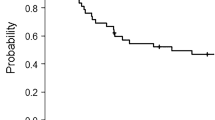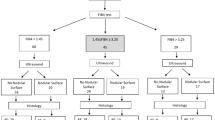Abstract
Sinusoidal obstruction syndrome (SOS) is a potentially fatal complication of hematopoietic stem cell transplantation (HSCT). Traditional ultrasound (US) has poor sensitivity and specificity. US shear wave elastography (SWE) is a newer technology that measures liver stiffness. This is a single-institution, prospective cohort study evaluating SWE in patients younger than 21 years who received HSCT from December 2015 through June 2017. SOS was defined using the modified Seattle criteria. Subjects had US with SWE at three scheduled time points. t-tests were used to assess for difference between the groups and ROC curves were generated. Twenty-five patients were included. Five subjects developed SOS. At day +5 HSCT, SOS patients had SWE velocities that increased by 0.25 ± 0.21 m/s compared to 0.02 ± 0.18 in patients without SOS (p = 0.020). At day +14, SOS patients had SWE velocities that significantly increased by 0.91 m/s ± 1.14 m/s compared to 0.03 m/s ± 0.23 m/s in patients without SOS (p = 0.010). SWE SOS diagnosis occurred on average 9 and 11 days before clinical and conventional US diagnosis, respectively. Patients who develop SOS have increased liver stiffness compared to patients who do not develop SOS. SWE changes occur before other imaging and clinical findings of SOS.
This is a preview of subscription content, access via your institution
Access options
Subscribe to this journal
Receive 12 print issues and online access
$259.00 per year
only $21.58 per issue
Buy this article
- Purchase on Springer Link
- Instant access to full article PDF
Prices may be subject to local taxes which are calculated during checkout




Similar content being viewed by others
References
Barker CC, Butzner JD, Anderson RA, Brant R, Sauve RS, Incidence, survival and risk factors for the development of veno-occlusive disease in pediatric hematopoietic stem cell transplant recipients. Bone Marrow Transplant. 2003;32:79–87.
Reiss U, Cowan M, McMillan A, Horn B, Hepatic venoocclusive disease in blood and bone marrow transplantation in children and young adults: incidence, risk factors, and outcome in a cohort of 241 patients. J Pediatr Hematol Oncol. 2002;24:746–50.
Cesaro S, Pillon M, Talenti E, Toffolutti T, Calore E, Tridello G, et al. A prospective survey on incidence, risk factors and therapy of hepatic veno-occlusive disease in children after hematopoietic stem cell transplantation. Haematologica. 2005;90:1396–404.
McDonald GB, Hinds MS, Fisher LD, Schoch HG, Wolford JL, Banaji M, et al. Veno-occlusive disease of the liver and multiorgan failure after bone marrow transplantation: a cohort study of 355 patients. Ann Intern Med. 1993;118:255–67.
Carreras E, Granena A, Navasa M, Bruguera M, Marco V, Sierra J, et al. On the reliability of clinical criteria for the diagnosis of hepatic veno-occlusive disease. Ann Hematol. 1993;66:77–80.
Coppell JA, Richardson PG, Soiffer R, Martin PL, Kernan NA, Chen A, et al. Hepatic veno-occlusive disease following stem cell transplantation: incidence, clinical course, and outcome. Biol Blood Marrow Transplant. 2010;16:157–68.
Sharafuddin MJ, Foshager MC, Steinbuch M, Weisdorf DJ, Hunter DW, Sonographic findings in bone marrow transplant patients with symptomatic hepatic venoocclusive disease. J Ultrasound Med. 1997;16:575–86.
Carreras E, Granena A, Navasa M, Bruguera M, Marco V, Sierra J, et al. Transjugular liver biopsy in BMT. Bone Marrow Transplant. 1993;11:21–6.
Shulman HM, Gooley T, Dudley MD, Kofler T, Feldman R, Dwyer D, et al. Utility of transvenous liver biopsies and wedged hepatic venous pressure measurements in sixty marrow transplant recipients. Transplantation. 1995;59:1015–22.
Herbetko J, Grigg AP, Buckley AR, Phillips GL. Venoocclusive liver disease after bone marrow transplantation: findings at duplex sonography. AJR Am J Roentgenol. 1992;158:1001–5.
Teefey SA, Brink JA, Borson RA, Middleton WD, Diagnosis of venoocclusive disease of the liver after bone marrow transplantation: value of duplex sonography. AJR Am J Roentgenol. 1995;164:1397–401.
Barr RG, Ferraioli G, Palmeri ML, Goodman ZD, Garcia-Tsao G, Rubin J, et al. Elastography assessment of liver fibrosis: society of radiologists in ultrasound consensus conference statement. Radiology. 2015;276:845–61.
Bamber J, Cosgrove D, Dietrich CF, Fromageau J, Bojunga J, Calliada F, et al. EFSUMB guidelines and recommendations on the clinical use of ultrasound elastography. Part 1: Basic principles and technology. Ultraschall Med. 2013;34:169–84.
Cosgrove D, Piscaglia F, Bamber J, Bojunga J, Correas JM, Gilja OH, et al. EFSUMB guidelines and recommendations on the clinical use of ultrasound elastography. Part 2: Clinical applications. Ultraschall Med. 2013;34:238–53.
Harris PA, Taylor R, Thielke R, Payne J, Gonzalez N, Conde JG, Research electronic data capture (REDCap)—a metadata-driven methodology and workflow process for providing translational research informatics support. J Biomed Inform. 2009;42:377–81.
Fontanilla T, Hernando CG, Claros JC, Bautista G, Minaya J, Del Carmen Vega M, et al. Acoustic radiation force impulse elastography and contrast-enhanced sonography of sinusoidal obstructive syndrome (Veno-occlusive disease): preliminary results. J Ultrasound Med. 2011;30:1593–8.
Auberger J, Graziadei I, Clausen J, Vogel W, Nachbaur D. Non-invasive transient elastography for the prediction of liver toxicity following hematopoietic SCT. Bone Marrow Transplant. 2013;48:159–60.
Corbacioglu S, Greil J, Peters C, Wulffraat N, Laws HJ, Dilloo D, et al. Defibrotide in the treatment of children with veno-occlusive disease (VOD): a retrospective multicentre study demonstrates therapeutic efficacy upon early intervention. Bone Marrow Transplant. 2004;33:189–95.
Acknowledgements
This work was partially funded by a Children’s Mercy Cancer Center grant awarded to Dr. Reddivalla. The authors acknowledge the Children’s Mercy Medical Writing Center for their help with manuscript preparation.
Author information
Authors and Affiliations
Corresponding author
Ethics declarations
Conflict of interest
SC has received a research grant from GE Healthcare for another research project involving digital tomosynthesis. JD and MR are medical consultants for Jazz Pharmaceuticals.
Rights and permissions
About this article
Cite this article
Reddivalla, N., Robinson, A.L., Reid, K.J. et al. Using liver elastography to diagnose sinusoidal obstruction syndrome in pediatric patients undergoing hematopoetic stem cell transplant. Bone Marrow Transplant 55, 523–530 (2020). https://doi.org/10.1038/s41409-017-0064-6
Received:
Revised:
Accepted:
Published:
Issue Date:
DOI: https://doi.org/10.1038/s41409-017-0064-6
This article is cited by
-
Point shear-wave elastography for the diagnosis of veno-occlusive disease in children and young adults
Pediatric Radiology (2023)
-
Assessment of hepatic veno-occlusive disease/sinusoidal obstruction syndrome using different scanning approaches for the ultrasonographic evaluation of portal vein blood flow and hepatic artery resistive index in hematopoietic stem cell transplant recipients
Journal of Medical Ultrasonics (2023)
-
Utility of liver stiffness measurement in the diagnosis of sinusoidal obstruction syndrome/veno-occlusive disease after hematopoietic stem cell transplantation
Journal of Medical Ultrasonics (2023)
-
Multiparametric MRI with MR elastography findings in patients with sinusoidal obstruction syndrome after oxaliplatin-based chemotherapy
Insights into Imaging (2022)
-
Analysis of determinant factors of liver fibrosis progression in ex-thalassemic patients
International Journal of Hematology (2021)



